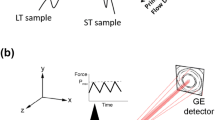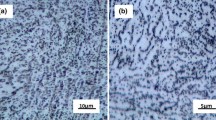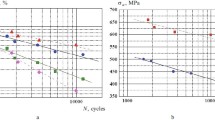Abstract
Stage fatigue crack propagation in Ti-6A1-4V has been studied as a function of various fracture mechanics parameters, including the stress intensity range (ΔK) and both positive and negative ratios of the minimum to maximum stress (R). It was found that the fracture surface appearance undergoes a transition from cyclic cleavage to striations at a ΔKeff of approximately 13 MNm-3/2 (11.8 ksi√in.). It was also observed that the measured striation spacings are generally within a factor of two of the optically measured crack growth rates. Both of these results can be particularly useful for determining unknown component cyclic loadings during failure analysis. The criterion for the cyclic cleavage to striation transition is considered to be a change from primarily single to multiple slip within the individual grains at the crack tip. This occurs when the cyclic plastic zone size becomes approximately equal to the α grain size.
Similar content being viewed by others

References
S. W. Hopkins, A. Rau, A. Yuen, and G. R. Leverant:Fatigue Crack Propagation in Regions of Deformation-Induced Residual Stress, Pratt & Whitney Aircraft, Middletown, Connecticut, unpublished research. (To be published.)
R. G. Forman,et al:ASME D, 1967, vol. 89, no. 3, p. 459.
W. Elber:Eng. Frac. Mech., 1970, vol. 2, p. 37.
N. J. I. Adams:Eng. Frac. Mech., 1972, vol. 4, p. 543.
E. F. J. von Euw, R. W. Hertzberg, and R. Roberts:Amer. Soc. Test. Mater., Spec. Tech. Publ. 513, Part 1,1972, p. 230.
T. T. Shih and R. P. Wei: NASA CR-2319, October 1973.
G. T. Hahn, R. G. Hoagland, and A. R. Rosenfield:Met. Trans., 1972, vol. 3, p. 1189.
H. Wells and P. Sullivan:Trans. ASM, 1969, vol. 62, p. 263.
N. E. Paton, J. Williams, and G. P. Rauscher: Second International Conference on Titanium, MIT, May 1972.
D. J. Duquette and M. Gell:Met. Trans., 1971, vol. 2, p. 1325.
K. R. L. Thompson and J. V. Craig:Met. Trans., 1970, vol. 1, p. 1047.
M. Gell and G. R. Leverant:ActaMet., 1968, vol. 16, p. 553.
M. Gell and G. R. Leverant:Trans. TMS-AIME, 1968, vol. 242, p. 1869.
F. E. Organ and M. Gell:Met. Trans., 1971, vol. 2, p. 943.
L. A. Burck, P. Sullivan, and H. Wells:Met. Trans., 1970, vol. 1, p. 1595.
G. A. Miller, D. H. Avery, and W. A. Backofen:Trans. TMS-AIME, 1966, vol. 236, p. 1667.
M. R. Achter:ScriptaMet., 1968, vol. 2, p. 525.
P. G. Partridge:Metallurgical Reviews, 1967, vol. 12, p. 169.
R.J. Bucci,et al.:ASTM STP 513, 1972, p. 125.
Author information
Authors and Affiliations
Rights and permissions
About this article
Cite this article
Yuen, A., Hopkin, S.W., Leverant, G.R. et al. Correlations between fracture surface appearance and fracture mechanics parameters for stage II fatigue crack propagation in TÏ-6AI-4V. Metall Trans 5, 1833–1842 (1974). https://doi.org/10.1007/BF02644148
Received:
Published:
Issue Date:
DOI: https://doi.org/10.1007/BF02644148



